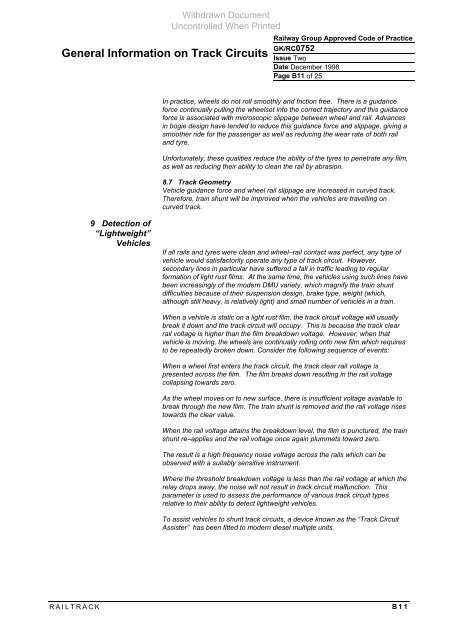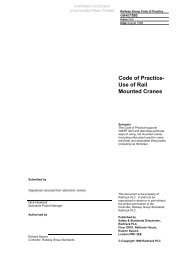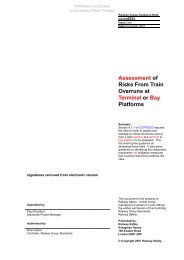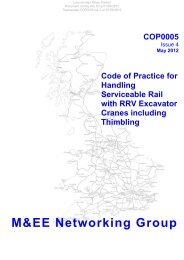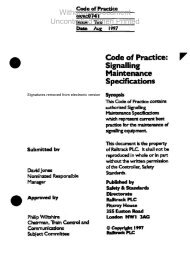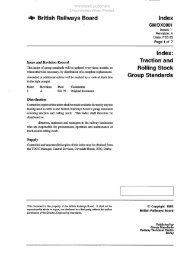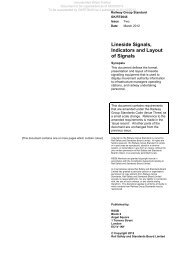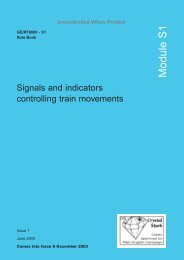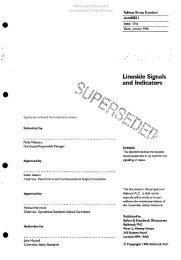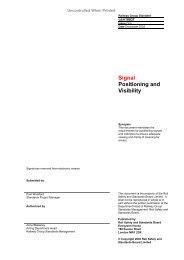General Information on Track Circuits - RGS Online
General Information on Track Circuits - RGS Online
General Information on Track Circuits - RGS Online
Create successful ePaper yourself
Turn your PDF publications into a flip-book with our unique Google optimized e-Paper software.
<str<strong>on</strong>g>General</str<strong>on</strong>g> <str<strong>on</strong>g>Informati<strong>on</strong></str<strong>on</strong>g> <strong>on</strong> <strong>Track</strong> <strong>Circuits</strong><br />
9 Detecti<strong>on</strong> of<br />
“Lightweight”<br />
Vehicles<br />
Withdrawn Document<br />
Unc<strong>on</strong>trolled When Printed<br />
Railway Group Approved Code of Practice<br />
GK/RC0752<br />
Issue Two<br />
Date December 1998<br />
Page B11 of 25<br />
In practice, wheels do not roll smoothly and fricti<strong>on</strong> free. There is a guidance<br />
force c<strong>on</strong>tinually pulling the wheelset into the correct trajectory and this guidance<br />
force is associated with microscopic slippage between wheel and rail. Advances<br />
in bogie design have tended to reduce this guidance force and slippage, giving a<br />
smoother ride for the passenger as well as reducing the wear rate of both rail<br />
and tyre.<br />
Unfortunately, these qualities reduce the ability of the tyres to penetrate any film,<br />
as well as reducing their ability to clean the rail by abrasi<strong>on</strong>.<br />
8.7 <strong>Track</strong> Geometry<br />
Vehicle guidance force and wheel rail slippage are increased in curved track.<br />
Therefore, train shunt will be improved when the vehicles are travelling <strong>on</strong><br />
curved track.<br />
If all rails and tyres were clean and wheel–rail c<strong>on</strong>tact was perfect, any type of<br />
vehicle would satisfactorily operate any type of track circuit. However,<br />
sec<strong>on</strong>dary lines in particular have suffered a fall in traffic leading to regular<br />
formati<strong>on</strong> of light rust films. At the same time, the vehicles using such lines have<br />
been increasingly of the modern DMU variety, which magnify the train shunt<br />
difficulties because of their suspensi<strong>on</strong> design, brake type, weight (which,<br />
although still heavy, is relatively light) and small number of vehicles in a train.<br />
When a vehicle is static <strong>on</strong> a light rust film, the track circuit voltage will usually<br />
break it down and the track circuit will occupy. This is because the track clear<br />
rail voltage is higher than the film breakdown voltage. However, when that<br />
vehicle is moving, the wheels are c<strong>on</strong>tinually rolling <strong>on</strong>to new film which requires<br />
to be repeatedly broken down. C<strong>on</strong>sider the following sequence of events:<br />
When a wheel first enters the track circuit, the track clear rail voltage is<br />
presented across the film. The film breaks down resulting in the rail voltage<br />
collapsing towards zero.<br />
As the wheel moves <strong>on</strong> to new surface, there is insufficient voltage available to<br />
break through the new film. The train shunt is removed and the rail voltage rises<br />
towards the clear value.<br />
When the rail voltage attains the breakdown level, the film is punctured, the train<br />
shunt re–applies and the rail voltage <strong>on</strong>ce again plummets toward zero.<br />
The result is a high frequency noise voltage across the rails which can be<br />
observed with a suitably sensitive instrument.<br />
Where the threshold breakdown voltage is less than the rail voltage at which the<br />
relay drops away, the noise will not result in track circuit malfuncti<strong>on</strong>. This<br />
parameter is used to assess the performance of various track circuit types<br />
relative to their ability to detect lightweight vehicles.<br />
To assist vehicles to shunt track circuits, a device known as the “<strong>Track</strong> Circuit<br />
Assister” has been fitted to modern diesel multiple units.<br />
RAILTRACK B11


